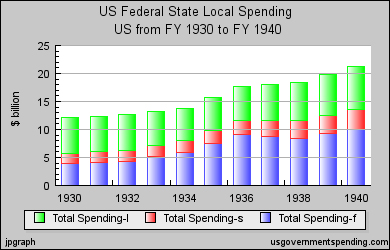July 27, 2011
Over at the Heritage blog, David Weinberger attempted a fact-check. He wrote, “But both Professor Krugman and President Obama have their history entirely incorrect. Total government spending never decreased in the 30s, certainly not after 1937. Rather, total government spending went up”
Sure enough, the graph presented shows no fall in government spending between 1936 and 1937.

Weinberger should have taken a closer look at his own source material. Ignoring for the moment that the spending is in current dollars, not adjusted for inflation (even though usgovernmentspending.com allows the option) let us look at the table at Weinberger’s source.

Legend:?i – interpolated between actual reported values?, a – actual reported
It turns out that usgovernmentspending.com doesn’t have data for 1937 at all. It merely averages 1936 and 1938 to arrive at a figure for 1937. (usgovernmentspending.com’s own source is clearly the Historical Statistics of the United States: Colonial Times to 1970, Series Y 533-566, on page 1120.)
So what really happened in 1937? If we turn instead to the Bureau of Economic Analysis, NIPA Table 3.1, we see that between 1936 and 1937, current expenditures fell from $12.8 billion to $12.0 billion (not adjusted for inflation.) Government investment net of consumption of fixed capital fell from $2.9 billion to $2.5 billion. In nominal terms, BEA shows a fall in government spending of 7.7 percent.
Turning to NIPA Table 1.1.4, we see that inflation in government consumption and gross investment rose 2.1 percent from 1936 to 1937. (Prices in this sector actually grew slower than in any other area.) This implies that real government spending fell 9.6 percent.
Weinberger failed to present inflation-adjusted data, and presented a rise in spending from 1936 to 1937 as valid history when his source clearly indicated otherwise. The data was wholly unsuitable to address the claims by Krugman and Obama. Heritage presented an utter failure of a fact-check.






